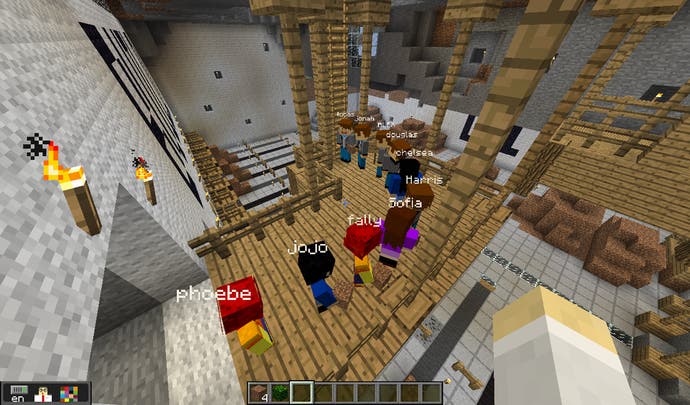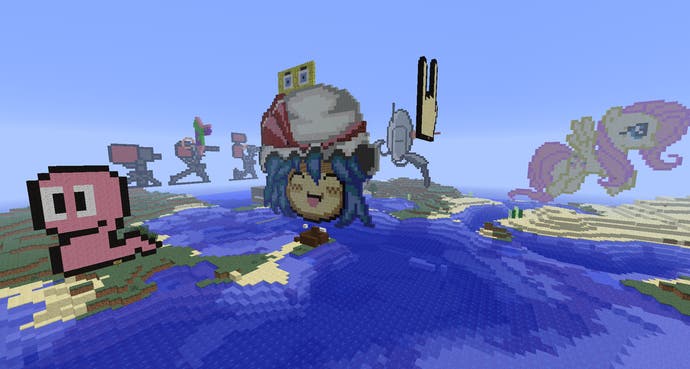Learn to Play: Minecraft in the classroom
Eurogamer discovers how a New York school is using games for good.
Imagine being eight years old today. You pack your bag, hop on a bus, act like your crush has cooties and go through lessons on history, English, maths, science, and... Minecraft?
That's the reality for about 200,000 kids today who have Minecraft in their schools as part of the curriculum.
Educational software is nothing new, but most "edutainment" (I reckon there's no dirtier word in the gaming vernacular) games were traditional curriculum wearing the guise of a video game as convincingly as Superman posing as a journalist by wearing glasses.
These days that's changed. There's no longer a barrier between education and fun when big games by popular developers are being used to teach our children.

It all started when then 35 year old New York-based computer teacher Joel Levin began playing the Minecraft alpha in the summer of 2010. Instantly he was enamoured with the open-world game's emphasis on creativity, problem solving, building and discovery. He then showed it to his four year old daughter, who caught on to Notch's indie phenomenon shockingly fast.
"I was really impressed with the sorts of things she was doing in the game and how it was really enforcing her to be self reliant and solve problems and it was furthering her to do some very basic research online - and even doing very simple math problems," he says.
That's when Levin knew he needed to bring it outside of his home and into the Columbia Grammar and Preparatory School in New York City where he worked as an IT teacher.
Nearly two years later Levin is still using Minecraft in his class, but he also runs a business called TeacherGaming that sells a customised user-friendly version of the game dubbed MinecraftEdu to schools - a project officially sanctioned by Mojang, who give discounts to educators.
But before all that he showed it to a second-grade class of seven and eight year olds. "It was like nothing I'd ever seen before as a teacher," Levin glows during a mid-afternoon Skype chat between classes.
"These kids were just so excited to be at school. They couldn't wait to get to school to get a taste of more Minecraft. They were writing stories about it in English class, they were drawing pictures of it in art class."
It soon became apparent that Minecraft could be used outside of Levin's class to teach kids in all areas of education. "Everyone started seeing this level of excitement, this level of engagement and realised we were kind of onto something here."

This wasn't the first time Levin wanted to incorporate video games into his curriculum, but it never quite worked how he wanted. "I've used a number of other games in school, but to be honest I was never that excited about it," he said, noting he'd considered Spore, Civilization and Second Life. "I felt like I was shoehorning my lessons to fit the game, but Minecraft is the first game to come along where I feel like I can reshape the game to fit my lessons."
The reason for this is Minecraft's hugely open-ended customisation. Teachers can set up private servers and go on digital field trips with their students without having to worry about the ugly reality of other online players.
Levin's heard from history teachers who would bring their students to virtual versions of ancient Rome or Egypt and English teachers who would let their students have little adventures in the game followed by journal activities where they would write about their latest exploits.
"I've heard from teachers who say, 'Here's a kid I could never get to pick up a pencil or keyboard and start writing until he played Minecraft. Suddenly, I can't make him stop!'"
He further explained that a science teacher in Australia built a mod for the game where kids explore 3D models of cells and role-play as proteins and DNA, while an ESL teacher in Denmark had fantastic results having his kids play with the only rule being that they had to communicate in English. "He said he's never seen results like this. Because the kids are so motivated to communicate with each other they're mastering English."
Social studies teachers could even use the virtual mutliplayer landscape to have their students form their own governments. This happened naturally in a high school Minecraft club that Levin oversees.
"If we're building a town, how's it going to be governed?" he asked the group. "Is it going to be a monarchy? Are you going to elect the leader? Do you want me to be the leader? Are you going to vote on everything? Is it a democracy?"
"The kids sat there and they had this very long, very detailed discussion arguing the pros and cons of different forms of government."
"Part of my job with second graders is to introduce the idea of internet research," Levin explained. "How to find information online, how to judge from a Google search what's trustworthy information. It was always a struggle to get the kids to do that, but with Minecraft they are so eager to learn new tricks and new strategies and new things you can do in the game that they are excited to do the research. These are vital skills that will transfer to them the rest of their life and academic careers."
Levin says a lot of students gained an interest in programming because they wanted to modify Minecraft. While these are usually 14 and 15 year olds he noted that there's one fourth grader (about nine years old) he predicts will be "the next John Carmack or something".
"Part of my job is figuring out where a kid's passion lies and if Minecraft is the motivating factor in getting them to be interested in these activities. Then you just encourage them and point them towards resources."
Beyond purely academic pursuits, Levin found Minecraft created an environment where kids can simulate real world situations.
Perhaps the best example of this started when two kids - a boy and a girl - were building a house next to each other in the game. The girl accidentally broke a window in the boy's house, at which point he leaped out of his chair, threw it to the ground and started yelling, "What are you doing? Get out of my house! How could you do that?"
"At first I was like, 'Oh god, I need to calm this kid down,'" Levin recalls. "But then I thought, 'No, this is a golden opportunity.' I paused the class and said, 'How are we dealing with this? If this were happening in the real world, is this how you would talk to her? What's the right way to resolve this situation?'
"So when these younger kids are playing together it's like one by one they're role-playing all these real world situations. It's been a great way to start the conversation and just learn about compromise and common decency and respect. And frankly just teach the golden rule."

This expands outside of the classroom and into the digital world as well. Levin notes that a few years ago the sixth, seventh and eighth grade classes (11-14 year olds) were getting into trouble on social networks Facebook, Twitter and Chat Roulette. The school decided it needed to intervene earlier and teach younger kids about "digital citizenship," which Levin describes as an umbrella term encompassing internet privacy and how we communicate, collaborate and share online.
"Our hope is in a few years when these kids are getting on Facebook or whatever's popular at the time, we've successfully modeled for them the right ways to interact with each other online and hopefully avoid some of these ugly experiences."
But one downside to Minecraft is that it could turn into an obsession for the students if they're not careful.
"It's not all peaches and roses," Levin says. "There have been some kids where it's become something of an obsession. Their parents are reporting finding them sneaking to the computer in the middle of the night to get more game time in, but this is really a parenting issue. It's about setting limits for your kids and making sure they're keeping up their other responsibilities."
Unfortunately, there's no easy answer for this. Levin, as a father of two, says he's still trying to negotiate this delicate balance between screen time and everything-else time.
"This is uncharted territory. Teachers and parents all over the world are still trying to figure this out, and it's so important we figure it out. If you just say to a kid you can't ever watch TV or you can't ever play video games, you're doing them a disservice because in 2012 they are surrounded by these things and it's part of their life and their world and they should be exposed to it."
While Minecraft is only mandated a half-hour a week, Levin laughs, "The students who are really into it will find ways to get more."
I don't know about you, but when I was in school I can't remember anyone wanting to do more homework.









